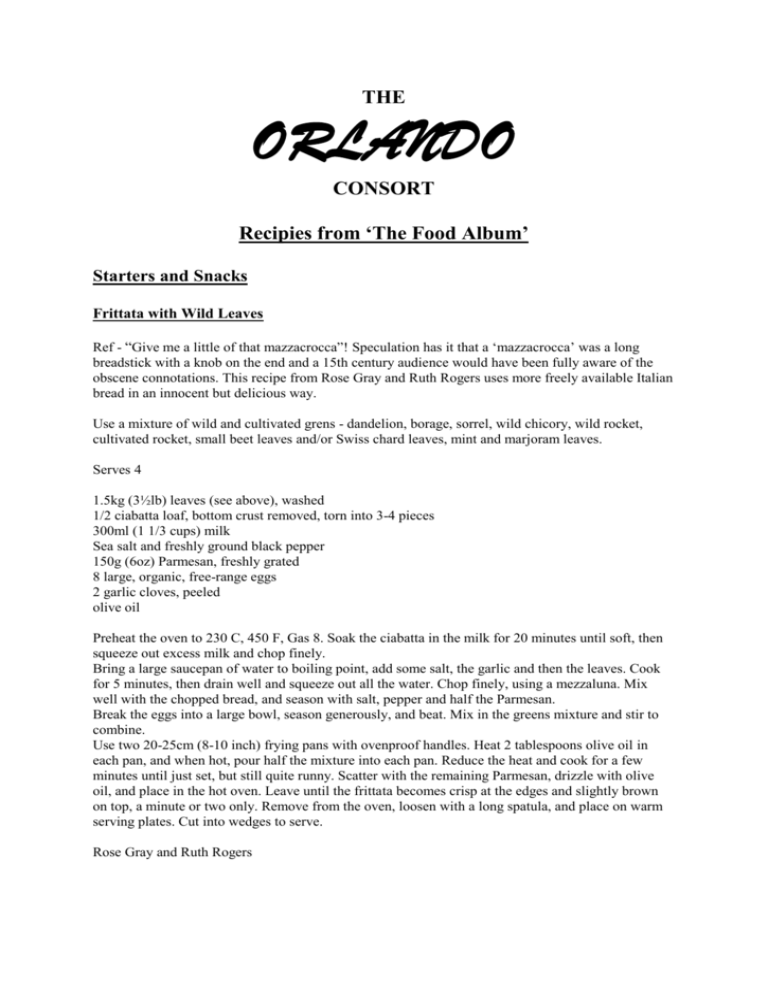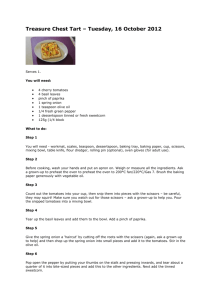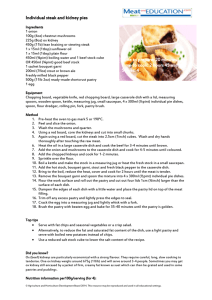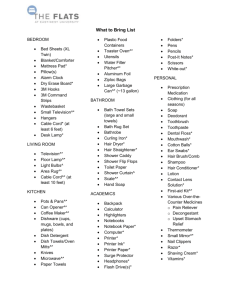Serves 6
advertisement

THE ORLANDO CONSORT Recipies from ‘The Food Album’ Starters and Snacks Frittata with Wild Leaves Ref - “Give me a little of that mazzacrocca”! Speculation has it that a ‘mazzacrocca’ was a long breadstick with a knob on the end and a 15th century audience would have been fully aware of the obscene connotations. This recipe from Rose Gray and Ruth Rogers uses more freely available Italian bread in an innocent but delicious way. Use a mixture of wild and cultivated grens - dandelion, borage, sorrel, wild chicory, wild rocket, cultivated rocket, small beet leaves and/or Swiss chard leaves, mint and marjoram leaves. Serves 4 1.5kg (3½lb) leaves (see above), washed 1/2 ciabatta loaf, bottom crust removed, torn into 3-4 pieces 300ml (1 1/3 cups) milk Sea salt and freshly ground black pepper 150g (6oz) Parmesan, freshly grated 8 large, organic, free-range eggs 2 garlic cloves, peeled olive oil Preheat the oven to 230 C, 450 F, Gas 8. Soak the ciabatta in the milk for 20 minutes until soft, then squeeze out excess milk and chop finely. Bring a large saucepan of water to boiling point, add some salt, the garlic and then the leaves. Cook for 5 minutes, then drain well and squeeze out all the water. Chop finely, using a mezzaluna. Mix well with the chopped bread, and season with salt, pepper and half the Parmesan. Break the eggs into a large bowl, season generously, and beat. Mix in the greens mixture and stir to combine. Use two 20-25cm (8-10 inch) frying pans with ovenproof handles. Heat 2 tablespoons olive oil in each pan, and when hot, pour half the mixture into each pan. Reduce the heat and cook for a few minutes until just set, but still quite runny. Scatter with the remaining Parmesan, drizzle with olive oil, and place in the hot oven. Leave until the frittata becomes crisp at the edges and slightly brown on top, a minute or two only. Remove from the oven, loosen with a long spatula, and place on warm serving plates. Cut into wedges to serve. Rose Gray and Ruth Rogers Mushroom Pasties Ref - This recipe comes from the ‘Goodman of Paris’, an anonymous book written at the time of Chaucer and Guillaume de Machaut. The author, apparently a civil servant and landowner, advises on how to handle servants, how to manage a garden, and how to shop effectively in the Parisian markets, as well as assembling a comprehensive selection of recipes. These are sophisticated little pasties which would be perfect for ‘al fresco’ dining or even the kind of picnic scene depicted in Adam de La Halle’s ‘Jeu de Robin et Marion’. 450g (1lb) shortcrust pastry, made with half butter, half lard 450g (1lb) mushrooms (Paris mushrooms are best) 2 tbsp olive oil Salt and black pepper 55g (2oz) cheddar cheese (grated) ¼ tsp dry mustard 1 egg, beaten With two thirds of the pastry, line small deep pattypans. Chill. Preheat oven to 200 C, 400 F, Gas 5/6. Trim off mushroom stalks. In a sieve dip mushrooms into boiling water for 2 minutes. Drain them, then pat dry and chop them. Put them into a bowl and mix with the oil, cheese and seasonings. Fill the pastry cases with the mixture. Roll out the remaining pastry and make lids for the cases. Seal the lids with the beaten egg. Make a small cross in the centre of each lid. Bake in the oven for 15-18 minutes. Serve warm. Clarissa Dickson Wright Main Courses - Meat Roast Pork with Spiced Red Ref - ‘Nowell, nowell: The boarës head’. This dish comes from the Curye on Inglysch collection and was originally known as ‘Cormarye’. It was specifically designed with pork in mind, but it would definitely be worth using the same marinating technique if you can track down a butcher who can lay his hands on boar. Serves 4-6 (allow at least 2 hours to marinate the meat) 1.35kg (3lb) piece loin of pork with skin 2 medium onions, sliced 1 clove of garlic 1 bay leaf 1 level tablespoon fennel seeds, roughly crushed in a pestle and mortar Freshly milled black pepper 250ml (½ pint) red wine Freshly ground sea salt 25g (1oz) flour About 250ml (½ pint) vegetable or chicken stock 2 teaspoons quince or apple jelly Ask your butcher to chine the loin of pork and score the skin well, but ask him not to remove the bone and not to tie or roll the joint up with string. Place the meat in a china or earthenware dish. Combine the onions, garlic, bay leaf, fennel seeds and black pepper with the red wine to make a marinade. Pour over the meat and leave to marinate for at least 2 hours. Remove the joint, reserving the marinade. Dry the skin of the pork with kitchen paper, then sit the joint upright, resting on the bones, in a shallow roasting tin. Sprinkle the scored surface of the skin generously with salt to give it a thick coating, then cook for 20 minutes in the oven at 240 C, 475 F, Gas 9. Lower the heat to 190 C, 375 F, Gas 5 and continue roasting for 1hr and 10mins. (To make sure that the meat is cooked, test with a skewer - the juices should run clear, not pink). Place the pork on a serving dish and leave to rest in a warm place, while you make the gravy. To make the gravy, remove most of the fat from the roasting tin. Stir the flour into the pan juices and cook for a few minutes. Pour in the strained marinade and continue to stir over heat until smooth. Add the stock and allow to bubble for about 15 minutes until rich and glossy. Stir in about 2 teaspoons of quince or apple jelly and adjust the seasoning as necessary. To serve, carve the meat into thick slices, including the crackling, and pour over the red wine sauce. Sara Paston-Williams Pheasant cooked in Red Wine with Spices and Parsley Ref - ‘Je ne vis onques’. This song is known to have been sung at the ‘Feast of the Pheasant’ in 1453 and one must imagine that pheasant would have featured on the menu. This recipe is based on one to be found in ‘Le recueil de Riom’, a collection compiled at least in part by M. Chavillat in 1466. A bottle of good Burgundian red wine would form the perfect accompaniment to this dish. Serves 4 2 Prepared Pheasants 8 Onions 1 Head of celery 8 Large carrots 1 Head of garlic 250g (10oz) Parsley Clove Cinnamon stick 1 Bottle red wine 1 Lt. (2 pints) Chicken stock 1 Bay leaf Rosemary Thyme Juniper berries Method 1. Peel are prepare all vegetables 2. Pan fry all the vegetables until golden brown 3. Seal the pheasants and place in a large saucepan or braising dish 4. Add the vegetables to the pheasants 5. Add the red wine, all the herbs and spices, and the parsley stalks 6. Pour the chicken stock over so the pheasants are completely covered in liquid. (A glass of port could be added for extra flavour) 7. Cover with a lid and place in a warm oven, braise for an hour and a half or until the pheasant is completely cooked 8. Remove from the oven, cut the pheasant into portions, chop the vegetables in half, and reduce the red wine cooking liquor by half. To serve: Place the vegetables in the bottom of a dish, arrange the pheasant on top Pass the cooking liquor and pour a little over the pheasant. Sprinkle with freshly chopped parsley and serve immediately. Jean-Christophe Novelli Main Courses - Fish Haddock in Ale Ref - ‘Apparuerunt apostolis’. A very appropriate dish for the monks of Fountains Abbey, who brewed their own ale and who would have been expected on important holy days to eschew meat in favour of fish. This recipe has been adapted from an anonymous 15th century cookbook (Laud Ms 533), but any firm-fleshed white fish can be used. The best results have been achieved using good quality lagers as they tend to be closer in texture to medieval ales than modern bitters and stouts, the heavy taste of which can sometimes mask the flavour of the fish. Serves 4 450g (1lb) thick piece of skinned and filleted haddock 2 onions, finely sliced 65g (2½oz) butter Generous pinch of saffron Freshly milled black pepper Freshly ground sea salt 250ml (½pint) lager Flat-leaf parsley, roughly chopped Gently stew the onions with the saffron in 25g (1oz) butter for about 20 minutes, or until very soft but not browned. Spoon them into the bottom of a shallow ovenproof dish in which the fish will just fit. Lay the fish on top and season it well. Pour in the lager, then cover the dish with foil. Bake in a moderate oven 180 C, 350 F, Gas 4 for about 20 minutes until the fish is just cooked through. Strain off the liquor into a small pan and reduce rapidly by fast boiling to intensify the flavour. Divide the fish and onions between 4 shallow bowls (old-fashioned soup plates are ideal) and keep warm. Whisk the remaining butter into the liquor and pour over the fish. Sprinkle with plenty of parsley and then serve with fresh crusty bread. Sara Paston-Williams Vegetables Leeks and Beetroot in Raisin Sauce This dish was a great favourite in medieval times but the recipe probably comes originally from Roman times. Leeks are an ancient vegetable which grew well all over Europe and were especially prized in France, Italy and Spain. The beetroot was much prized at the dinner table for its clear rich purple colour as well as its taste. This dish with its reduced sauce would be easily eaten in the fingers or with a spoon. 2 leeks, sliced. 225g (½lb) young whole beetroots 1 tsp coriander seeds ¼ tsp cumin seeds 55g (2oz) raisins 600ml (2 2/3 cups) vegetable stock olive oil white wine vinegar flour salt Grind together the cumin and coriander. Heat the stock and add the raisins and spices. Put in the vegetables, add salt and simmer until the vegetables are tender (about 25 minutes). Remove the vegetables from the sauce to a warm dish. Reduce the sauce, adding a little flour to thicken and a dash of oil and vinegar. Pour over vegetables and serve. Clarissa Dickson Wright Desserts Pear Tart Ref - ‘La plus grant chière’. With the Burgundian fondness for pies and pastries this might even have been one of the ‘fine dishes’ served at the party hosted by the composers Morton and Hayne. From ‘Le Viandier de Guillaume Tirel, dit Taillevent’. Serves 6 Ingredients 3 Ripe pears 1 Sweet pastry case 250g (9oz) Frangipan 150g (5oz) Caster sugar Saffron 100g (3½oz) Butter 100g (3½oz) Flour 1 Egg 100 ml (½ cup) double cream Rum (optional) 50g (2oz) Brown sugar Method 1. Peel the pears remove the cores and slice into quarters 2. Bake blind your pastry case 3. Place the frangipan in the bottom of the pastry case 4. 5. 6. 7. Mix the egg, double cream, sugar, saffron and a splash of rum together Place pear on top of flangipan Pour over the egg, cream and sugar mixture Place in a warm oven aprox 150 C, 300 F, Gas 2, for an hour and fifteen minutes until the pears are soft and the egg mixture has set 8. Crumb together the butter, flour and brown sugar and sprinkle over the tart 9. Place the tart back in the hot oven or under a grill until the topping is golden brown. Serve immediately. Jean-Christophe Novelli Saffron Cake Saffron, taken from the stamen of the crocus, was beloved by people in the Middle Ages, especially for its vivid colour. This is a sophisticated dish: saffron was and is horrendously expensive and baking in the 15th century was no easy matter, requiring as it did a brick oven heated by lighting a fire to raise the bricks to the right temperature. The fire was then raked out and the baking could begin. (I have used such an oven and can vouch for the fact that it is not easy to get it right!). As a consequence, yeasted cakes with a shorter cooking time were much favoured. Sultanas and raisins were dried in the sun, the finest coming from Cyprus. The mace in question was the herb mace, as the West Indies had not yet been discovered, but for your own purposes West Indian mace is just as good and certainly easier to come by. 450g (1lb) plain flour 12½g (½oz) yeast 110g (¼lb) butter 55g (2oz) castor sugar 55g (2oz) each sultanas and currants 150ml (2/3 cup) milk 1 tsp salt 1 tsp each powdered mace and mixed spice ½ tsp saffron filaments For glazing, 2 tbsp milk and 1 tbsp sugar. To prepare the saffron and the yeast. Take half the milk and heat to boiling point. Put the saffron filaments on a dish and put in a hot oven for 5 minutes. Crumble into a cup, pour over a little hot milk and leave to infuse. Pour the remaining hot milk, which by now will be luke warm, over the yeast and mix to a cream. Put the flour, sugar and salt in a warmed bowl. Sprinkle in the dry spices and stir in the creamed yeast. Now mix in the softened butter with your hands, and when it is well mixed add the saffron infusion and the remainder of the milk. The dough should be soft but not runny. Mix in the fruit, cover and leave to rise for a couple of hours. When it has doubled in volume, knock it down lightly. Sprinkle with flour, transfer to a buttered tin, and leave to rise for a second time. It is a slow rising dough and will take a minimum of 45 minutes to 1 hour to return to life and reach almost to the top of the tin. Bake in the centre of the oven at 200 C, 400 F, Gas 5/6 for 15 minutes. Move to a lower shelf and cook for a further 15 minutes. Remove from oven, glaze, and leave for 15 minutes before turning out. Although saffron cake is best enjoyed when freshly cooked, it can be reheated in a very low oven. It is a subtle accompaniment to a sweet Sauternes, a dessert wine, or a glass of Madeira. Clarissa Dickson Wright






